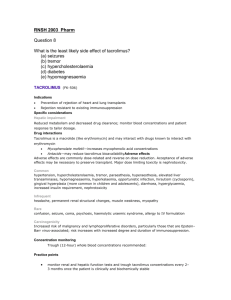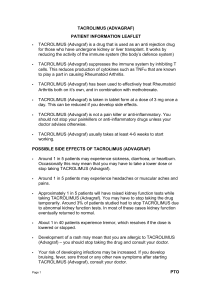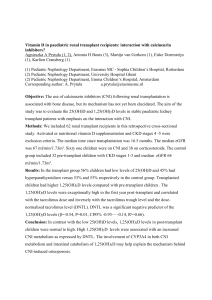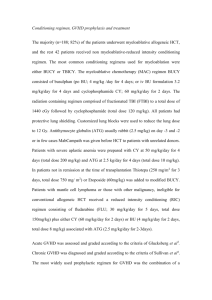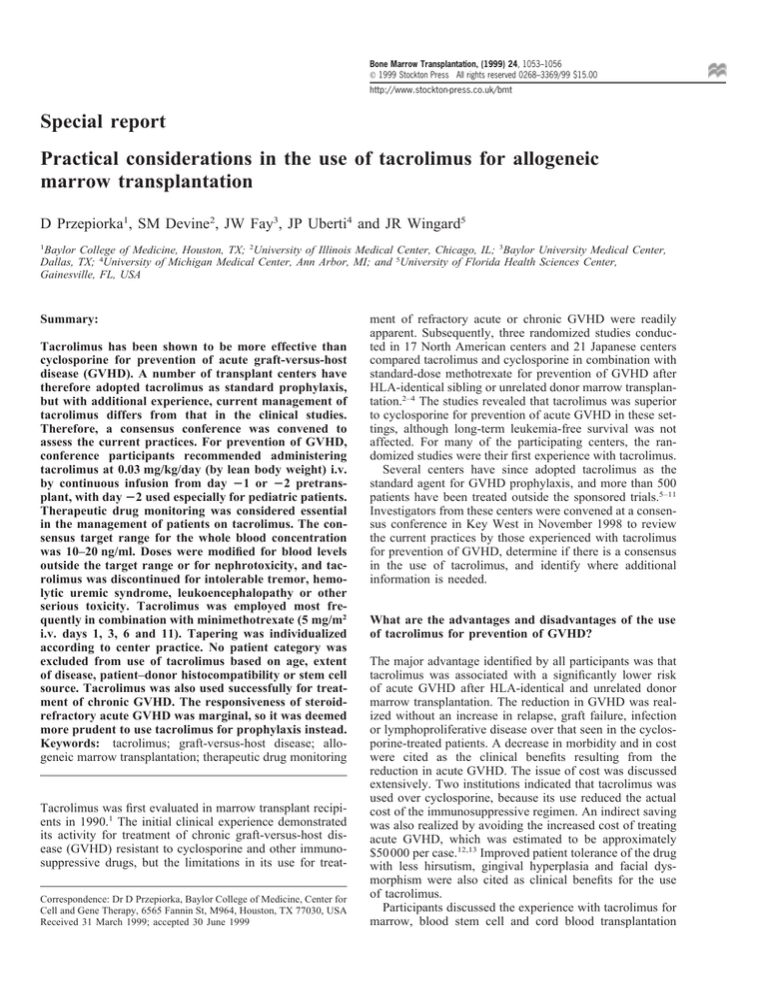
Bone Marrow Transplantation, (1999) 24, 1053–1056
1999 Stockton Press All rights reserved 0268–3369/99 $15.00
http://www.stockton-press.co.uk/bmt
Special report
Practical considerations in the use of tacrolimus for allogeneic
marrow transplantation
D Przepiorka1, SM Devine2, JW Fay3, JP Uberti4 and JR Wingard5
1
Baylor College of Medicine, Houston, TX; 2University of Illinois Medical Center, Chicago, IL; 3Baylor University Medical Center,
Dallas, TX; 4University of Michigan Medical Center, Ann Arbor, MI; and 5University of Florida Health Sciences Center,
Gainesville, FL, USA
Summary:
Tacrolimus has been shown to be more effective than
cyclosporine for prevention of acute graft-versus-host
disease (GVHD). A number of transplant centers have
therefore adopted tacrolimus as standard prophylaxis,
but with additional experience, current management of
tacrolimus differs from that in the clinical studies.
Therefore, a consensus conference was convened to
assess the current practices. For prevention of GVHD,
conference participants recommended administering
tacrolimus at 0.03 mg/kg/day (by lean body weight) i.v.
by continuous infusion from day ⴚ1 or ⴚ2 pretransplant, with day ⴚ2 used especially for pediatric patients.
Therapeutic drug monitoring was considered essential
in the management of patients on tacrolimus. The consensus target range for the whole blood concentration
was 10–20 ng/ml. Doses were modified for blood levels
outside the target range or for nephrotoxicity, and tacrolimus was discontinued for intolerable tremor, hemolytic uremic syndrome, leukoencephalopathy or other
serious toxicity. Tacrolimus was employed most frequently in combination with minimethotrexate (5 mg/m2
i.v. days 1, 3, 6 and 11). Tapering was individualized
according to center practice. No patient category was
excluded from use of tacrolimus based on age, extent
of disease, patient–donor histocompatibility or stem cell
source. Tacrolimus was also used successfully for treatment of chronic GVHD. The responsiveness of steroidrefractory acute GVHD was marginal, so it was deemed
more prudent to use tacrolimus for prophylaxis instead.
Keywords: tacrolimus; graft-versus-host disease; allogeneic marrow transplantation; therapeutic drug monitoring
Tacrolimus was first evaluated in marrow transplant recipients in 1990.1 The initial clinical experience demonstrated
its activity for treatment of chronic graft-versus-host disease (GVHD) resistant to cyclosporine and other immunosuppressive drugs, but the limitations in its use for treatCorrespondence: Dr D Przepiorka, Baylor College of Medicine, Center for
Cell and Gene Therapy, 6565 Fannin St, M964, Houston, TX 77030, USA
Received 31 March 1999; accepted 30 June 1999
ment of refractory acute or chronic GVHD were readily
apparent. Subsequently, three randomized studies conducted in 17 North American centers and 21 Japanese centers
compared tacrolimus and cyclosporine in combination with
standard-dose methotrexate for prevention of GVHD after
HLA-identical sibling or unrelated donor marrow transplantation.2–4 The studies revealed that tacrolimus was superior
to cyclosporine for prevention of acute GVHD in these settings, although long-term leukemia-free survival was not
affected. For many of the participating centers, the randomized studies were their first experience with tacrolimus.
Several centers have since adopted tacrolimus as the
standard agent for GVHD prophylaxis, and more than 500
patients have been treated outside the sponsored trials.5–11
Investigators from these centers were convened at a consensus conference in Key West in November 1998 to review
the current practices by those experienced with tacrolimus
for prevention of GVHD, determine if there is a consensus
in the use of tacrolimus, and identify where additional
information is needed.
What are the advantages and disadvantages of the use
of tacrolimus for prevention of GVHD?
The major advantage identified by all participants was that
tacrolimus was associated with a significantly lower risk
of acute GVHD after HLA-identical and unrelated donor
marrow transplantation. The reduction in GVHD was realized without an increase in relapse, graft failure, infection
or lymphoproliferative disease over that seen in the cyclosporine-treated patients. A decrease in morbidity and in cost
were cited as the clinical benefits resulting from the
reduction in acute GVHD. The issue of cost was discussed
extensively. Two institutions indicated that tacrolimus was
used over cyclosporine, because its use reduced the actual
cost of the immunosuppressive regimen. An indirect saving
was also realized by avoiding the increased cost of treating
acute GVHD, which was estimated to be approximately
$50 000 per case.12,13 Improved patient tolerance of the drug
with less hirsutism, gingival hyperplasia and facial dysmorphism were also cited as clinical benefits for the use
of tacrolimus.
Participants discussed the experience with tacrolimus for
marrow, blood stem cell and cord blood transplantation
Practical considerations for use of tacrolimus
D Przepiorka et al
1054
using haploidentical, mismatched related, matched or mismatched unrelated, and haploidentical donors. There were
no concerns raised about use of tacrolimus in any of the
subgroups. When assessing the survival disadvantage in the
advanced disease patients in the randomized sibling study,3
the participants unanimously felt that this resulted from an
imbalance in randomization of patients with poor prognosis. The case-control study showing no difference in survival for cyclosporine-treated disease-matched controls
compared to the tacrolimus arm was cited to support this
opinion.14 In fact, advanced leukemia was the indication
for transplantation where tacrolimus was used most
frequently by the participants.
A question was raised regarding the inconsistency
between clear reduction in acute GVHD and absence of a
survival advantage in the standard-risk leukemia patients
treated with tacrolimus in the randomized studies.2–4 It was
pointed out that it is a rare supportive care study which
demonstrates a survival advantage in addition to the primary activity, and despite this, over the past 10 years there
has clearly been an increase in survival for transplant
recipients. It was concluded that the incremental improvements in outcome afforded by single changes in supportive
care could not be detected in the individual studies because
of the relatively small numbers of patients, but when
multiple changes in supportive care are considered in
aggregate, the improvement in outcome is obvious.
The only disadvantage cited for use of tacrolimus was
that the intravenous formulation was given by continuous
infusion. This was the preferred method of administration,
because of the high rates of neurologic and renal toxicities
seen when the drug was administered by rapid or short
infusions twice daily. However, it was pointed out that the
dose of drug given by short infusion in those early solid
organ transplant patients was much higher than that used
for marrow transplantation, and there is no published
experience with shorter infusions using the current lower
dose.
What is the tacrolimus dose-schedule for GVHD
prophylaxis?
The initial dose of tacrolimus is 0.03 mg/kg/day i.v. based
on lean body weight. The use of lean rather than actual
body weight was considered by some a departure from their
usual method for dosing cyclosporine. The participants
initiated administration of tacrolimus on the morning of day
⫺1 or the evening of day ⫺2 prior to transplantation.
Recent data were cited regarding the fact that pediatric
patients have a higher clearance of tacrolimus.15,16 Despite
this, those treating pediatric patients did not utilize a higher
initial dose; they recommended that the drug be started on
day ⫺2 in children to ensure that steady state had been
achieved by the time of transplantation.
All centers continued intravenous administration through
engraftment, with conversion to oral in a 1:4 i.v.:p.o. ratio,
and oral drug was given in two divided doses daily. It was
pointed out, however, that a proportion of patients have
a higher absorption of tacrolimus, so patients should be
monitored closely when converting to oral drug to ensure
appropriate dosing.
The duration of administration of tacrolimus varied
between centers and depended on the indication for transplantation. The recommendation made was to taper
tacrolimus in a fashion similar to how one would using
cyclosporine.
How are patients monitored during treatment with
tacrolimus, and how are doses modified?
All participants indicated that whole blood levels of tacrolimus were measured regularly, and the results were used
for dose modifications. This was cited as another departure
from the standard management of cyclosporine, wherein
many of the investigators modified doses of cyclosporine
only if toxicity was seen. Support cited for the practice of
close therapeutic monitoring when using tacrolimus
included two analyses which showed a sharp increase in
nephrotoxicity with whole blood levels exceeding
20 ng/ml.17,18 In general, whole blood levels were measured
beginning 24 to 48 h after initiation of the i.v. infusion.
Measurements were made at least three times per week in
the peritransplant period, and once or twice per week in
stable outpatients. There was no indication for continued
therapeutic monitoring once tapering had begun if the
patient remained stable.
More frequent measurement of whole blood levels was
indicated in patients who became acutely ill, especially
when developing liver dysfunction, or after starting treatment with drugs known to have a pharmacologic interaction
with tacrolimus. Pre-emptive dose modification when starting such drugs, or when starting nephrotoxic agents such
as amphotericin, was not utilized by any of the study participants. For these situations, it was considered more prudent to monitor drug levels more frequently rather than to
lower the dose and risk development of GVHD.
Frequent monitoring of creatinine routinely accompanied
the use of tacrolimus, and dose modifications were recommended on the basis of both renal insufficiency (Table
1) and whole blood drug levels (Table 2). The target therapeutic range cited was 10–20 ng/ml. The upper limit of
20 ng/ml comes from the analysis correlating toxicity with
higher blood levels.17,18 The lower limit of 10 ng/ml was
due to the fact that there is less published experience using
lower target levels. A number of centers have used an upper
level of 15 ng/ml, which allowed for an interval of 5 ng/ml
before getting into the range of increased risk of nephrotoxicity. Some centers have also allowed the blood levels to
remain in the 5 to 10 ng/ml range if the patient is clinically
stable. A small amount of experience with whole blood tacrolimus levels below 5 ng/ml suggested that the risk of
Table 1
Tacrolimus dose modification for renal insufficiency
Serum creatinine
1.0–1.5 ⫻ baseline
1.6–1.9 ⫻ baseline
⬎1.9 ⫻ baseline
Tacrolimus dose
75–100% of current dose
25–50% of current dose
Hold and resume at 50% of current dose if
renal dysfunction is stable
Practical considerations for use of tacrolimus
D Przepiorka et al
Table 2
Tacrolimus i.v. dose modification by concentrationa
Tacrolimus level
(ng/ml)b
⬍5
5–9
10–15
16–20
21–25
⬎25
Change in tacrolimus dose
Increase by 25–50%
Increase by 0–25%
No change
Decrease by 0–25%c
Hold 6 h and resume at 50% dosec
Hold and resume at 25% dose when level
is ⬍20c
a
Trough concentrations are not proportional to dose when the drug is given
orally. Oral dose modifications should be individualized.
b
Whole blood concentration measured by IMx assay.
c
Tacrolimus clearance may be excessively prolonged for patients with liver
dysfunction or while on medication that inhibits hepatic P450 function.
In these patients, hold tacrolimus and follow levels daily to determine
when to restart administration.
methotrexate for HLA-identical blood stem cell transplantation.22 The investigators listed methotrexate,23 methylprednisolone, daclizumab and other monoclonal anti-T cell
antibodies, mycophenolate mofetil, thalidomide and antithymocyte globulin as other immunosuppressives used in
combination with tacrolimus without clinically apparent
adverse interactions.
Although the North American studies utilized standard
dose methotrexate, most participants currently employ the
minimethotrexate regimen (methotrexate 5 mg/m2 i.v. days
1, 3, 6 and 11). The rationale for the lower dose of methotrexate was a safety issue. Most investigators found that
standard-dose methotrexate could not be tolerated by
patients receiving current preparative regimens because of
extreme mucositis. Moreover, in a phase II multicenter trial
of tacrolimus for GVHD prophylaxis after unrelated donor
transplantation, there was no difference in risk of GVHD
between the groups treated with standard methotrexate or
with minimethotrexate.24
GVHD was increased, and levels below 5 ng/ml were to
be avoided.
How should tacrolimus be used for treatment of acute
GVHD?
What were the indications to discontinue use of
tacrolimus?
The experience of the participants indicated that the toxicity
profile of tacrolimus was similar to that of cyclosporine,
except that fewer patients on tacrolimus had hypertension.3,4,19 Intolerable side-effects were identified as the most
common reason to discontinue tacrolimus. These included
severe tremor, hemolytic uremic syndrome (HUS) and leukoencephalopathy. It was felt that tremor was not doserelated but idiosyncratic; however, no data were available
regarding whether patients with tremors on tacrolimus were
tolerant of cyclosporine. Not all participants uniformly discontinued use of tacrolimus for HUS or leukoencephalopathy. In some cases, the drug was stopped only temporarily,
or the dose was reduced and subsequently continued without recurrence of HUS or leukoencephalopathy. However,
most participants preferred to utilize an alternative
immunosuppressive drug in these circumstances. A number
of participants have also used tacrolimus for patients who
had developed HUS or leukoencephalopathy while receiving cyclosporine without either of these toxicities recurring.
However, the numbers of patients developing HUS or leukoencephalopathy were too small to allow firm conclusions
regarding management of immunosuppressive therapy.
Should tacrolimus be used alone or in combination
with other immunosuppressive drugs for GVHD
prophylaxis?
Monotherapy has been used successfully for GVHD
prophylaxis,20 and selected centers have continued to use
monotherapy when the risk of GVHD is not considered to
be high. The advantages of combination therapy over
monotherapy were first reported in a preclinical study,21
and a similar conclusion was drawn in a recent retrospective analysis comparing tacrolimus to tacrolimus and
For patients developing acute GVHD while on tacrolimus,
all participants recommended measuring the whole blood
tacrolimus concentration to ensure that it was in the therapeutic range. All agreed that if the blood level was within
the range, the dose should not be increased further, since
there was no evidence to suggest that increasing blood levels above the target range was beneficial, but there was
substantial evidence that it would increase toxicity.17,18
Thus, for patients developing acute GVHD while on tacrolimus with a therapeutic blood level, initiation of treatment
with high-dose corticosteroids was indicated. For patients
developing visceral GVHD while on oral tacrolimus, it
was recommended that intravenous dosing be utilized,
since it is not known whether the peak level or the AUC
contributed to the activity of the drug.
For patients developing acute GVHD while on cyclosporine, there was some experience discussed using tacrolimus
as salvage therapy. The response rate for patients with steroid-refractory acute GVHD treated with tacrolimus was
generally less than 20%, and survival was poor. The strategy of using tacrolimus only for treatment of acute GVHD
was reviewed; however, because of the very low response
rate, this strategy was considered unacceptable.
How should tacrolimus be used for treatment of
chronic GVHD?
Participants indicated that they had used tacrolimus successfully for treatment of chronic GVHD developing off
immunosuppressive therapy and as salvage therapy for
patients who were cyclosporine failures. In these cases, tacrolimus was administered the same way as for prophylaxis,
although the drug could be started orally at 0.06 mg/kg
twice daily. The therapeutic target range and monitoring of
drug levels and creatinine were also the same as recommended for prophylaxis. When used for front-line ther-
1055
Practical considerations for use of tacrolimus
D Przepiorka et al
1056
apy of chronic GVHD, most participants used monotherapy
or combination therapy with corticosteroids as they would
previously have used with cyclosporine, and the duration
of therapy was also the same as with cyclosporine.
In summary, the study participants uniformly favored use
of tacrolimus over cyclosporine as GVHD prophylaxis
because of the reduction in morbidity associated with the
lower incidence of acute GVHD. Experience demonstrated
tacrolimus was an active immunosuppressive agent for
alternative donor transplantation as well as with transplantation of hematopoietic stem cells other than marrow, and
the lower dose-schedule of methotrexate was used by most
of the participants in conjunction with tacrolimus. The consensus dose-schedule of tacrolimus was 0.03 mg/kg/day by
continuous infusion, and therapeutic monitoring was used
to ensure that the tacrolimus whole blood concentration
remained in the range of 10–20 ng/ml. Doses were also
modified for nephrotoxicity and other serious adverse
events, but more information was needed regarding use of
tacrolimus in patients with hemolytic-uremic syndrome and
leukoencephalopathy after transplantation.
Acknowledgements
Support for the conference was generously provided by Fujiwasa
Healthcare, Inc. Institutions from which data was submitted and/or
presented included: Baylor College of Medicine, Houston; Baylor
University Medical Center, Dallas; Emory University, Atlanta;
MD Anderson Cancer Center, Houston; University of Florida
Health Sciences Center, Gainesville; University of Illinois,
Chicago; and University of Michigan, Ann Arbor.
References
1 Fung JJ, Tzakis A, Przepiorka D, Starzl T. FK506 for the
treatment of resistant liver involvement in chronic graft-versus-host disease: a pilot study. Blood 1990; 76: 539a.
2 Hiraoka AF for the Japanese FK506 BMT Study Group.
Results of a phase III study on prophylactic use of FK506 for
acute GVHD compared with cyclosporine in allogeneic bone
marrow transplantation. Blood 1997; 90: 561a.
3 Ratanatharathorn V, Nash RA, Przepiorka D et al. Phase III
study comparing methotrexate and tacrolimus (Prograf,
FK506) with methotrexate and cyclosporine for graft-versushost disease prophylaxis after HLA-identical sibling bone
marrow transplantation. Blood 1998; 92: 2303–2314.
4 Nash RA, Antin JH, Karanes C et al. A phase III study comparing methotrexate and tacrolimus with methotrexate and
cyclosporine for prophylaxis of acute graft-versus-host disease
after marrow transplantation from unrelated donors. Blood
1997; 90: 561a.
5 Nash RA, Pineiro LA, Storb R et al. FK506 in combination
with methotrexate for the prevention of graft-versus-host disease after marrow transplantation from matched unrelated
donors. Blood 1996; 88: 3634–3641.
6 Przepiorka D, Ippoliti C, Khouri I et al. Tacrolimus and minidose methotrexate for prevention of acute graft-versus-host
disease after matched unrelated donor marrow transplantation.
Blood 1996; 88: 4383–4389.
7 Przepiorka D, Ippoliti C, Khouri I et al. Allogeneic transplantation for advanced leukemia: improved short-term outcome
with blood stem cell grafts and tacrolimus. Transplantation
1996; 62: 1806–1810.
8 Devine SM, Geller R, Lin LB et al. The outcome of unrelated
donor bone marrow transplantation in patients with hematologic malignancies using tacrolimus (FK506) and low dose
methotrexate for graft-versus-host disease prophylaxis. Biol
Blood Marrow Transplant 1997; 3: 25–33.
9 Uberti JP, Silver SM, Adams PW et al. Tacrolimus and
methotrexate for the prophylaxis of acute graft-versus-host
disease in allogeneic bone marrow transplantation in patients
with hematologic malignancies. Bone Marrow Transplant
1997; 19: 1233–1238.
10 Przepiorka D, Petropoulos D, Mullen C et al. Tacrolimus for
prevention of graft-versus-host disease after mismatched unrelated donor cord blood transplantation. Bone Marrow Transplant 1999; 23: 1291–1296.
11 Przepiorka D, Khouri I, Ippoliti C et al. Tacrolimus and minidose methotrexate for prevention of acute graft-versus-host
disease after HLA-mismatched marrow or blood stem cell
transplantation. Bone Marrow Transplant (in press).
12 Gorman K, Henslee-Downey PJ, Carey G et al. Control of
graft-versus-host disease (GVHD) reduces cost of bone marrow transplantation. Blood 1991; 78: 231a.
13 Griffiths RI, Bass EB, Powe NR et al. Factors influencing
third party payer costs for allogeneic BMT. Bone Marrow
Transplant 1993; 12: 43–48.
14 Horowitz MM, Przepiorka D, Bartels P et al. Tacrolimus versus cyclosporine immunosuppression: results in advanced
stage disease patients with comparison to historical controls
treated exclusively with cyclosporine. Biol Blood Marrow
Transplant 1999; 5: 180–186.
15 Beltz S, Mehta P, Wingard JR. Pharmacokinetics of tacrolimus in children undergoing bone marrow transplantation
(BMT). Blood 1998; 92: 130a.
16 Blamble D, Danielson M, Chan K-W, Przepiorka D. Utilization and pharmacokinetics of tacrolimus in a pediatric marrow transplant population. Blood 1998; 92: 450a.
17 Wingard JR, Nash RA, Przepiorka D et al. Relationship of
tacrolimus (FK506) whole blood concentrations and efficacy
and safety after HLA-identical sibling bone marrow transplantation. Biol Blood Marrow Transplant 1998; 4: 157–163.
18 Przepiorka D, Nash RA, Wingard JR et al. Relationship of
tacrolimus whole blood levels to efficacy and safety outcomes
after unrelated donor marrow transplantation. Biol Blood Marrow Transplant 1999; 5: 94–97.
19 Woo MH, Przepiorka D, Ippoliti C et al. Toxicities of tacrolimus and cyclosporine after allogeneic blood stem cell transplantation. Bone Marrow Transplant 1997; 20: 1095–1098.
20 Fay JW, Wingard J, Antin JH et al. FK506 (tacrolimus) monotherapy for prevention of graft-versus-host disease after histocompatible sibling allogeneic bone marrow transplantation.
Blood 1996; 87: 3514–3519.
21 Yu C, Storb R, Deeg HJ et al. Tacrolimus (FK506) and methotrexate regimens to prevent graft-versus-host disease after
unrelated dog leukocyte antigen (DLA) nonidentical marrow
transplantation. Bone Marrow Transplant 1996; 17: 649–653.
22 Reynolds C, Ratanatharathorn V, Adams P et al. Comparative
analysis of tacrolimus/methotrexate versus tacrolimus in allogeneic peripheral blood stem cell transplants: engraftment,
GVHD, relapse, and survival outcomes. Blood 1998; 92: 449a.
23 Wingard JR, Nash RA, Ratanatharathorn V et al. Lack of
interaction between tacrolimus (FK506) and methotrexate in
bone marrow transplant recipients. Bone Marrow Transplant
1997; 20: 49–51.
24 Fay JW, Nash RA, Wingard J et al. FK506-based immunosuppression for prevention of graft-versus-host disease after
unrelated donor marrow transplantation. Transplant Proc
1995; 27: 1374.

